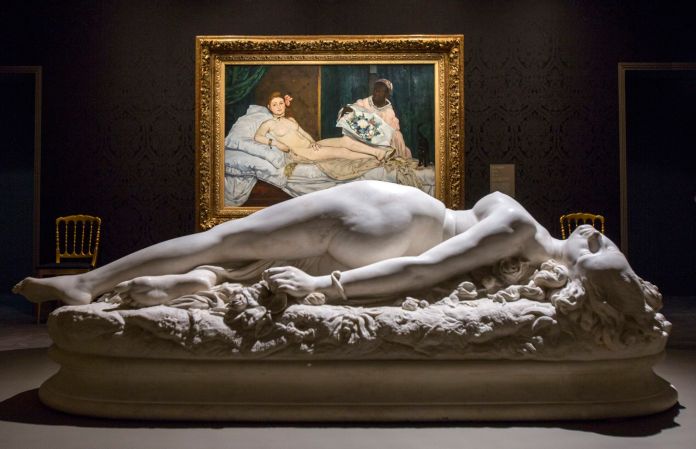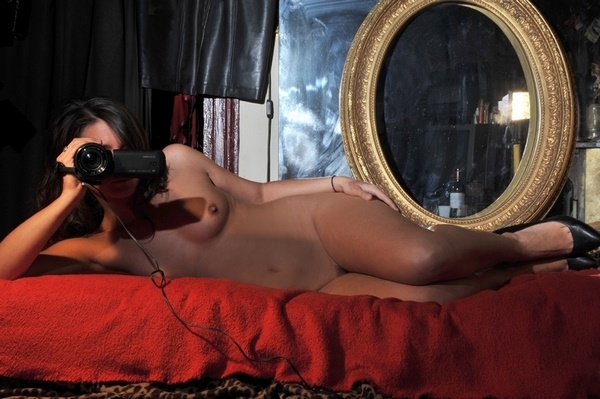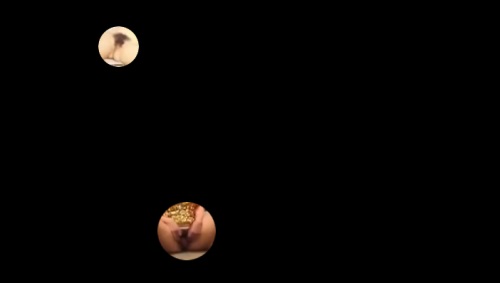
Édouard Manet, Olympia, 1863 & Auguste Clésinger, Femme piquée par un serpent [Woman Bitten by a Snake], 1847
Olympia dares to look at us. This is the real scandal: she is looking at us. This unworthy woman, showcased only to be glared at, sister to the nude featured on
an Orsay Museum poster inviting the public to come and look at nudes with their children (26 years after the famous
Guerrilla Girls poster which was taking to task the Met Museum), is looking at us. So passive, her desirable flesh ready for the taking, she should not have any agency, she should not be soliciting… And yet she dares to look at us in the eye, she dares to face us, brazenly, immodestly, defiantly. One day, maybe, we will
have her, as they say, thanks to our charm –or rather our money. But we won’t own her: possessing her will be more akin to submitting to her.

Deborah De Robertis, part of “Mémoire de l’Origine” [“Memory of the Origin”] series © Deborah De Robertis
It is not easy to adequately address
Deborah De Robertis’ work: too much noise, too much scandal, too much desire, too much voyeurism, too much lusting after possession, precisely, when we should let ourselves be possessed. It is too easy to only admire her (indisputably) beautiful body, feel content and not think twice about it. It is too easy to interpret it only as a narcissistic publicity stunt, and too easy as well to cry outrage at such indecency in a public place. In fact, it is too easy to only look at her and not
listen to her. For it is difficult, too difficult maybe, to shake off our prejudice (at least for me), to go beyond the disarray we might feel in front of her work. It is difficult to envision her, her declarations, her performances, with the same critical eye we use to look at
Gustave Courbet or
Gina Pane, with the same respectful, inquisitive and deconstructing outlook. Indeed, it is difficult to deal with our mental strabismus, our misalignment between well-established stereotypes and unresolved lustful entrapments. In order not to negate Deborah De Robertis, nor to refute, exclude, or censor her, one would need to be impartial, distant, respectful, almost ascetic in one’s approach… to such an extent that I am not sure I can do it myself. Am I reaching the limits of criticism, and of my own critical eye?

Deborah De Robertis, “Le modèle à la caméra” [“Model with a Videocamera”], still from video, © Deborah De Robertis & Marc Guillaume
And so, on Saturday, January 16, 2016, on the penultimate day of the exhibition
Splendeurs et Misères. Images de la Prostitution, 1850-1910 at the Orsay Museum,
Deborah De Robertis looked at those who were watching her, and even filmed them. Standing in front of the painting
Olympia by Manet, next to
Clésinger’s sculpture of Sabatier, the “Présidente”, writhing in pleasure under the pretense of a snake bite (pictured above), and facing the first representation of armpit hair in the history of painting –Théodore Chasseriau’s
Nymphe endormie [Sleeping Nymph], 1850–, she looked at us. Not far from an alcove featuring the contrived pose, in
contrapposto, of
Cléo de Mérode, cast from life (it was also the case for Sabatier, as indicated by the carryover, on the final marble sculpture, of the traces of her cellulite and of the folds of the plaster at her hip), and indifferent to the neighboring
photograph of the
Castiglione, the sole artwork in this exhibition that is signed –actually, the Castiglione co-signed it with
Pierre-Louis Pierson– by a woman (even though 100% of the nude paintings are female nudes, if this wasn’t obvious to everyone), she looked at us. Standing in front of
Olympia, she was looking at us and we were looking at her. She was filming us, and we were photographing her. (And it is well known that the Orsay Museum’s stance on photographing and filming in its rooms has long been
a source of trouble; here and then, in any case, filming and photographing were forbidden).

Anonymous montage (Ole Fach?) from a photograph of Deborah De Robertis’ performance in front of Courbet’s Origin of the World
The museum guards were trying to hide her, and the barrier they set in front of her was actually sublimating her, turning her into an artwork to be seen with caution. And the director of the museum (who is nearing the end of his mandate), who she was calling upon, was not coming. This director has played so much with desire and subversion in his recent exhibitions (here and there, and much more interestingly, here), and this director has tolerated (some said: “invited”) a naked man at the opening of the exhibition Masculin, Masculin. Yet, in May 2014, this director pressed charges against Deborah De Robertis for indecent exposure. Then, twenty months ago, she was already looking at us, playing with and against us, when, reclining below the Origin of the World, she opened a hole, before our eyes, like a camera lens looking at us. Then as well as now, people threw their hands in horror, and this director, this man of culture, wished to reduce De Robertis’ artistic and political gesture to mere indecent exposure, to sexual exhibitionism. This time around, in January 2016, we were all at her side as her black servant. Deborah was holding a flower bouquet similar to the one Manet painted, and –I almost forgot to mention it– she was naked, like Olympia.
OLYMPIA from Deborah De Robertis on Vimeo.
There is the video (you will see I was not a completely neutral observer…). Among the articles from the foreign press: The Guardian, and O Publico. And the award for comments goes to “Maskedavenger” in The Guardian’s article comment section: “I am all in favour of this woman’s ‘right’ to strip off wherever she wants (so long as, as Wellington noted, she doesn’t frighten the horses).”
Photos 2 & 3 courtesy of the artist.
Read this article:
in the original French; alt.
Original publication date by Lunettes Rouges: February 5, 2016.
Translation by Lucas Faugère




Pingback: Olympia te regarde, ou « Qui a peur de Deborah De Robertis ? | «lunettesrouges1